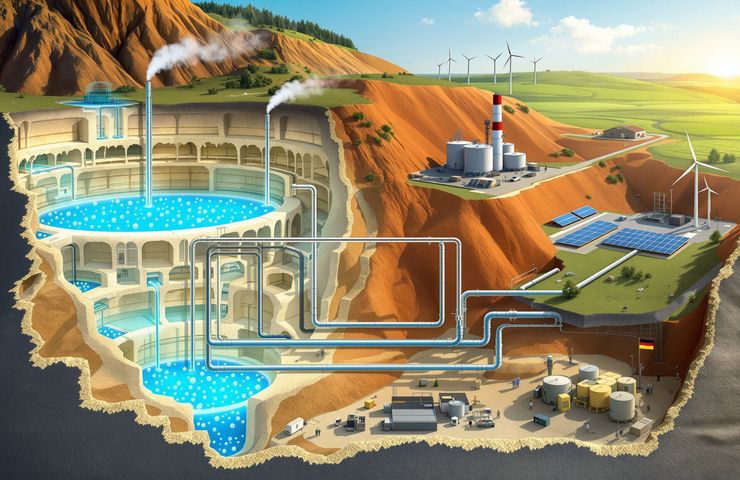
Hydrogen Storage: DVGW Pushes Urgent Rollout of Germany’s Hydrogen Infrastructure
October 27, 2025Just picture a labyrinth of underground chambers humming with green hydrogen, poised to fuel steelworks, refineries, and power stations across Germany. Hard to believe? It’s exactly what the DVGW (Deutscher Verein des Gas- und Wasserfaches) laid out on October 2025. They’re pushing for rapid expansion in hydrogen storage—and honestly, who could blame them?
Why Storage Matters
Struggling to match supply when the wind howls or the sun floods the grid with sunshine? Without space to stash that green hydrogen, you’re stuck. Germany’s ambitious shift toward sustainable energy hinges on smoothing out these wild swings. The National Hydrogen Strategy from 2021 already flagged hydrogen storage as mission-critical—but while electrolysers have rolled out like crazy and new pipelines are on the drawing board, storage has been playing catch-up. Plus, it’s a linchpin for industrial decarbonization, letting heavy factories swap gas and coal for a clean, green fuel.
Going Underground
If you’re looking underground, salt caverns are the MVP. These natural vaults—already battle-tested for natural gas—are basically perfect for hydrogen storage: leak-proof, massively roomy, and stable. A single cavern can hold upwards of 100 GWh of energy, enough to power thousands of homes for days on end. The DVGW also eyes old gas fields ready for a second act. Pump in hydrogen under pressure, let it sit until industry calls, then pull it back out. It’s straightforward, reliable, and taps into existing hydrogen infrastructure know-how.
Surface Solutions
But hey, not every solution needs to go caveman. Above ground, steel-tank storage is the quick win. Pilots are already popping up next to factories and research sites. Sure, they’re not as dramatic as cavern networks, but they’re nimble, fast to build, and perfect for showcase spots like the Bad Lauchstädt Energy Park.
Pipeline Power Play
And what about getting hydrogen where it needs to go? Germany’s tweaks to the EnWG energy law sketch out a backbone for a national hydrogen grid. By retrofitting old methane pipelines, you avoid starting from zero. This strategy leverages existing pipeline corridors, speeding up the rollout of robust hydrogen infrastructure. It’s a no-brainer route to hook storage hubs up to towns, industries, and anyone hungry for emissions-free fuel.
Policy and Projects
Across federal and regional levels, the green light’s been given: scenario frameworks, budgets, and permits are all lined up. The draft Network Development Plan even pinpoints several big hydrogen storage ventures, backed by a mix of state funding and private investment. Local authorities are jumping in too, trialing everything from shore-to-ship bunkering to hydrogen refueling depots for heavy transport. Sure, Germany’s per-capita GDP might hover around $51,500, but the real payoff comes from a resilient, zero-emission energy system that underpins future growth.
Industry Decarbonization in Sight
Picture steelmakers, chemical plants, and glass factories tapping into this supply. They’re dying for hydrogen to swap out blast furnaces, kick coal to the curb, and phase out gas-fired boilers. Reliable storage bridges the gap between fickle electrolyser output and consistent industrial demand. The result? Boosted competitiveness for Europe’s heavy industries and a big step toward Germany’s 2045 climate-neutral target.
Jobs, Skills and Safety
All this infrastructure means more than pipelines and tanks—it’s about people. Estimates point to over 5,000 new roles by 2030, covering geologists, engineers, welders, emergency responders, and digital monitoring specialists. But hydrogen’s a bit of a wild card, so specialized training is non-negotiable. That’s where the OGE hydrogen pipeline centre in Werne steps in: Europe’s one-stop school for safe handling, emergency drills, and the latest fire-and-explosion research that shapes our safety protocols.
Sector Coupling
The beauty of hydrogen storage is that it doesn’t just serve heavy industry. It stitches together power, heat, and mobility in one neat package. When renewables churn out excess juice, electrolysers convert it to hydrogen, which gets stashed away. Later, that same gas can rev up fuel cell technology—buses, trains, or backup generators—making every watt from wind farms and solar arrays count. And because hydrogen can be reconverted to electricity, thermal energy, or even blended into gas networks, it’s like a Swiss Army knife for our sustainable energy ambitions.
Export Potential
Fast forward to 2030: Germany could transform into Europe’s hydrogen clearinghouse, shipping surplus through the revamped pipeline network. It’s like having a savings account—if you want to lend out, you need a full vault. The DVGW’s push for bulkier storage ensures Germany’s ready when continental markets open their doors.
Looking Ahead
Of course, it’s not all smooth sailing. Electrolyser rollouts need to match storage timelines, red tape can slow things down, and not every underground site ticks all the boxes. But momentum is undeniable. With storage capacity finally center stage, Germany can weave its renewables expansion, hydrogen network, and industrial decarbonization goals into a single, zero-emission roadmap.
Here’s the thing: the idea that you can’t just build pipelines and electrolysers—you also need hydrogen storage—is spot on. It’s a cornerstone of the Draft Scenario Framework and all of DVGW’s publications. Skip ample storage, and you’re left with production peaks on one side and industrial thirst on the other.
It all comes down to timing. Electrolysers fire up when power prices dip, the grid gets a breather, hydrogen fills the tanks, and industries pull from the reserves when they need a steady, clean feed. That’s how intermittent renewables become a rock-solid backbone for our clean-energy future.
So next time you see drilling rigs near old gas fields or shiny steel tanks popping up on the horizon, know that it’s more than just construction. It’s Germany’s promise to keep the lights on, factories humming, and the planet a little cooler. And the DVGW just turned up the volume on that promise.


 With over 15 years of reporting hydrogen news, we are your premier source for the latest updates and insights in hydrogen and renewable energy.
With over 15 years of reporting hydrogen news, we are your premier source for the latest updates and insights in hydrogen and renewable energy.